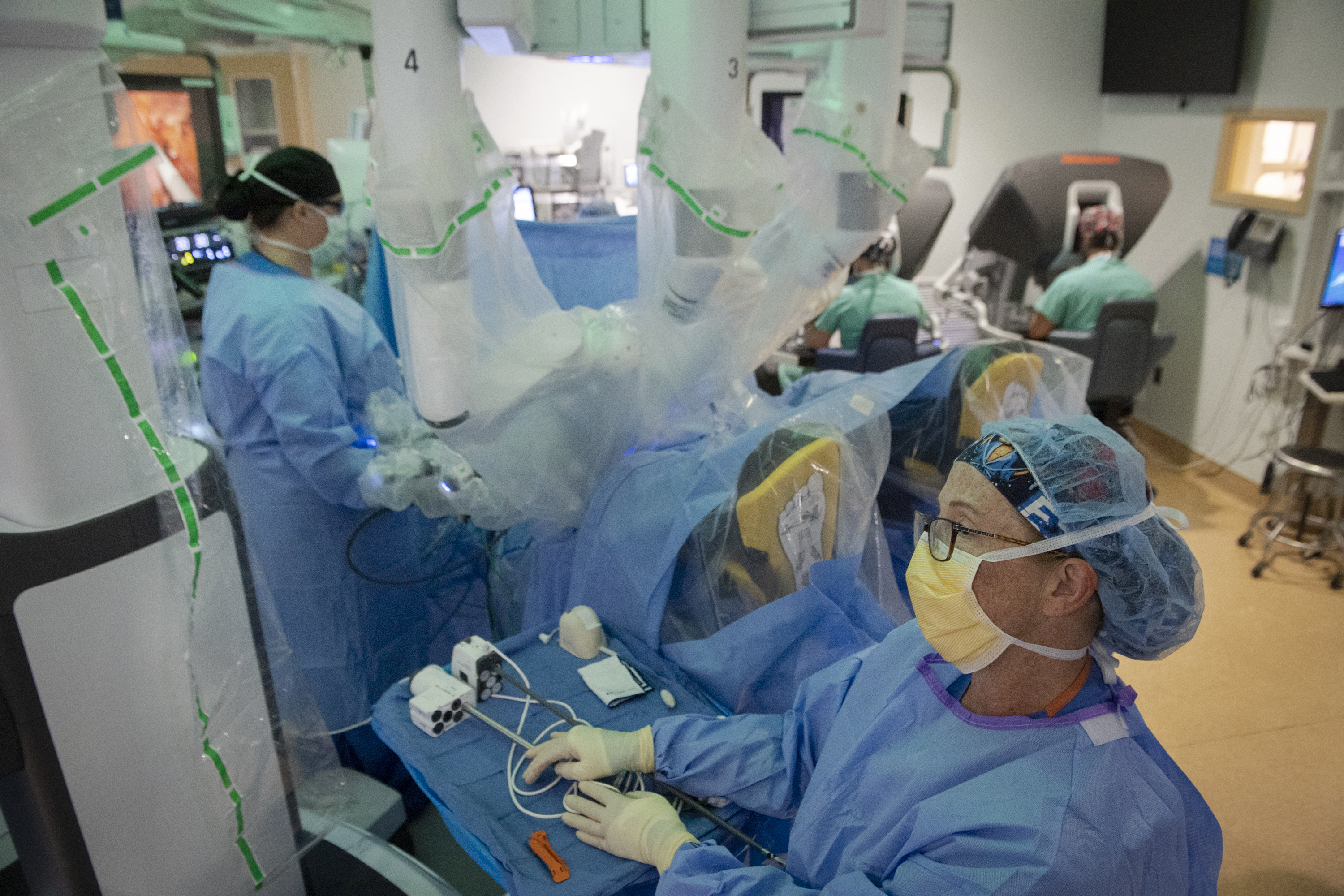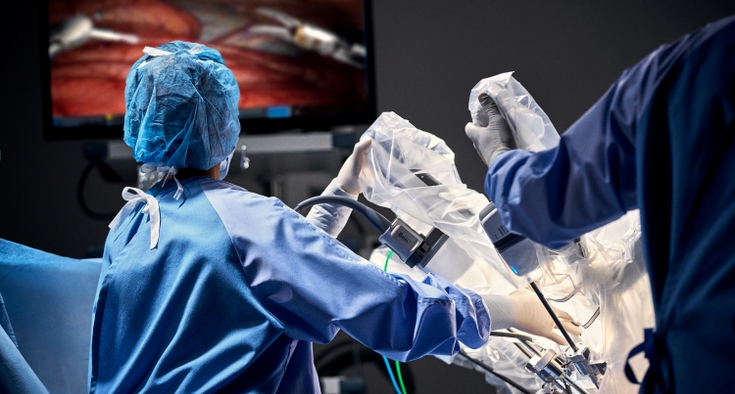If you have been diagnosed with prostate cancer, you aren’t alone, and you have options.
Those are the first things Dr. Brandon Craven, a urologist at Novant Health Urology - Baldwin in Winston-Salem, wants you to know.
You aren’t alone, because nearly 13 percent of men in the United States will be diagnosed with prostate cancer during their lifetime.
And you have options, because treatment for prostate cancer isn’t one-size-fits-all. Moreover, the side effects you may be worried about – like erectile dysfunction and incontinence – may not be as concerning as you have heard.
Dedicated specialists for prostate cancer prevention, detection and treatment.
There are three main treatment approaches your urologist will likely walk you through:
- Active surveillance
- Radiation
- Robotic prostatectomy
Learn more about which prostate cancer treatment approach might be right for you.
Active surveillance:
In this option, your urologist will not treat your cancer at all. Instead, they will monitor you to see if the cancer is growing. Active surveillance may be a good option if your cancer is confined to one area of the prostate, remains small and asymptomatic, and grows slowly.
Age also matters. If you are 75 or older, or have a shorter life expectancy due to another health condition, your doctor is likely to recommend active surveillance over treatment.
If you choose active surveillance, Craven recommends completing a repeat biopsy within a year of diagnosis. If the biopsy shows that the cancer hasn’t changed, or hasn’t changed much, he will check your PSA levels every six months, complete a rectal exam once a year, and perform MRI fusion biopsy every five years.
“We follow them until something changes, but the hope is, they live for many more years” without needing further cancer treatment, Craven said.
Active surveillance isn’t right for every case. If your urologist believes your prostate cancer requires treatment, you will choose between robotic prostatectomy and radiation.
Radiation
Radiation won’t happen at your urologist’s office. Instead, you will be referred to a radiation oncologist, who will often use “external beam radiation.” This painless therapy targets the cancer cells in your prostate gland with high-energy beams that destroy the cancer cells’ ability to grow and divide.
Top scores for safety in NC

Novant Health just received the most ‘As’ for patient safety in North Carolina from The Leapfrog Group. That includes Rowan Medical Center. With a focus on safety, quality and patient experience, the national, industry-leading nonprofit, evaluates and assigns letter grades ranging from A to F to hospitals across the country. Novant Health’s hospitals with “A” grades outperform 70% of hospitals nationwide for safety and quality.
The number of sessions you go through will be determined by your doctor. Often, patients will receive radiation five days a week for nine weeks, but some patients require less treatment or a shorter course. It all depends on your cancer.
Patients going through radiation typically experience fatigue and may experience other side effects, like bowel problems.
Because the beam therapy will also affect some of the healthy cells surrounding the cancer, side effects can include incontinence and erectile dysfunction, discussed in greater detail later in this article.
Robotic prostatectomy:
In robotic prostatectomy, your urologist will make five to six incisions in your abdominal area. One of the incisions fits a small camera, which allows your urologist to see inside your body during the procedure. The other incisions will allow your urologist to remove the prostate and any needed tissue, using a robotic tool that can operate in small spaces.
Because the incisions are small, the procedure is considered “minimally invasive,” allowing for a shorter recovery time and less pain during recovery.
Although you shouldn’t be in pain for long, after surgery you will likely experience incontinence and will need to learn to regain control of your bladder. Craven said this process can take from six weeks to six months, but that in his clinical experience, roughly 95% of men are satisfied with their urinary control at one year after surgery.
Additionally, immediately following surgery, you will not be able to have erections. Craven said 50% of his patients will regain them without long-term treatment. If you were able to have erections before surgery, Craven says, you can be sexually active again if you go through additional treatments. These treatments may include medication or other strategies.
Which is better?
Both radiation and robotic prostatectomy have side effects, which is one reason urologists don’t recommend treating every case of prostate cancer. Additionally, in many cases, prostate cancer grows so slowly that “it won’t be the thing that kills you,” Craven said.
For these reasons, in 2020, almost 60% of men with low-risk prostate cancer in the United States chose active surveillance, the National Cancer Institute reports.
In other cases, particularly if a patient is younger than 55, or if their cancer is advanced, treatment is recommended.
The treatments are both effective, and the 5-year survival rates of men choosing radiation or robotic prostatectomy are the same.
While the immediate side effects of a robotic prostatectomy may make it the less enticing option, “the risk is front-loaded,” Craven said. He means that patients who choose robotic prostatectomy lose erections and continence immediately upon surgery but are likely to get better as time goes on.
In contrast, patients who choose radiation are more likely to lose erections and continence over a longer time.
In general, Craven said, younger men benefit more from surgery, and older men from radiation.
You’re in charge
Craven typically looks at the patient’s age, health, habits, other risk factors, and treatment goals to come up with the most appropriate approach.
The patient ultimately chooses, Craven said, but a good urologist will still share their opinions.
“I will be honest with them and tell them that I think you're placing too much weight on your sexual function. That you need to focus on being alive for your grandkids. Alternatively, we may determine that we could cause you a lot of harm by treating, and that it's better to sit on this with active surveillance. I interject my opinion, but it's their body,” Craven said.
“I might be the captain helping steer their ship, but it's still their ship!”
Questions about prostate cancer? A urologist weighs in
What is the prostate?
The prostate is a small gland located just below the bladder. As part of the male reproductive system, it creates a fluid that nourishes sperm and helps it travel during ejaculation.
What is prostate cancer?
Prostate cancer happens when abnormal cell growth happens in the prostate gland. Some abnormal growths are benign (not cancerous), while others are malignant (cancerous).
If prostate cancer is located only in the prostate gland, it is considered “localized.” Prostate cancer can also spread to other parts of the body; if it spreads, it may be considered a “locally advanced” or “advanced” cancer.
What are the symptoms of prostate cancer?
Many patients with prostate cancer don't experience any symptoms, especially in the early stages. This is why it is important to get regular exams, including PSA tests, so your doctor can find and address prostate cancer before it becomes advanced.
As prostate cancer becomes more advanced, symptoms may include difficulty with urination, blood in urine or semen, pain and loss of appetite or weight.
Who diagnoses prostate cancer?
Generally, your urologist.
Who will be involved in treating your prostate cancer?
Your urologist’s office may be a “one-stop shop” for both diagnosis and treatment, or your urologist may also refer you to a radiation oncologist to discuss your options. If your cancer is no longer localized to the prostate, you may also consult with a medical oncologist.
Your urologist may also recommend other services such as physical therapy, counseling, or dietitian support, depending on your situation.










